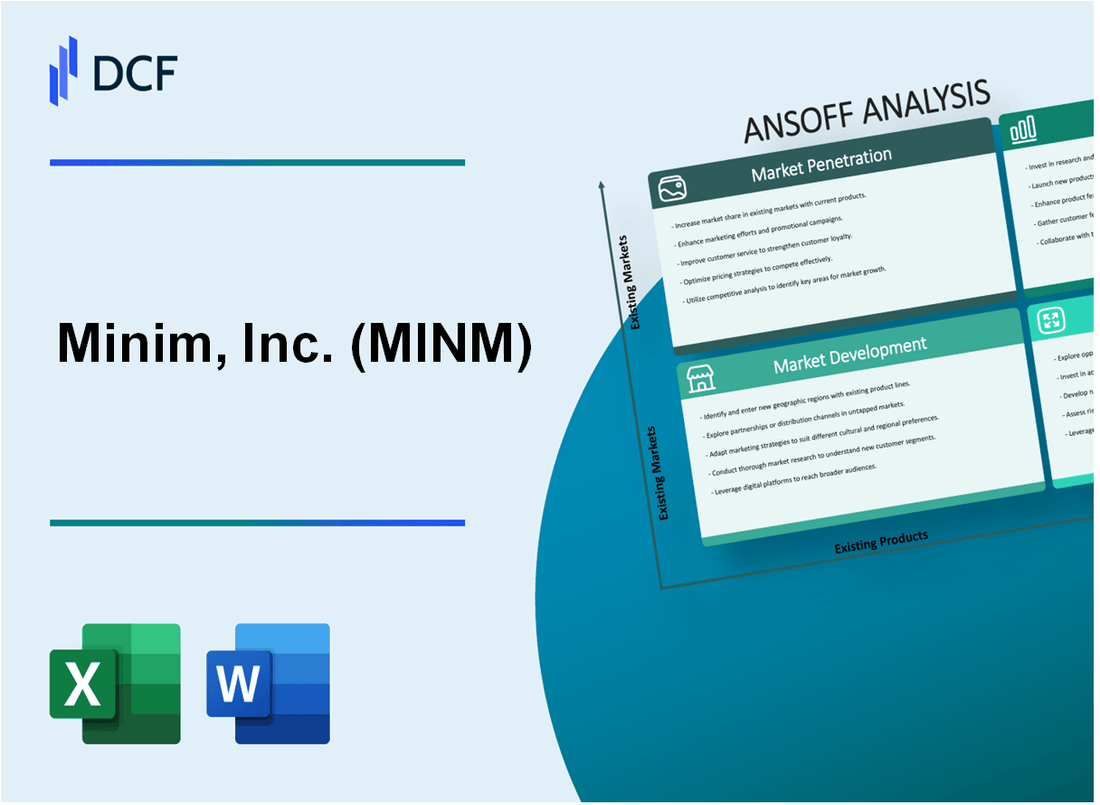
|
Minim, Inc. (MINM): ANSOFF Matrix Analysis [Jan-2025 Updated] |

- ✓ Fully Editable: Tailor To Your Needs In Excel Or Sheets
- ✓ Professional Design: Trusted, Industry-Standard Templates
- ✓ Pre-Built For Quick And Efficient Use
- ✓ No Expertise Is Needed; Easy To Follow
Minim, Inc. (MINM) Bundle
In the rapidly evolving landscape of network technology, Minim, Inc. (MINM) is strategically positioning itself for transformative growth across multiple dimensions. By meticulously crafting a comprehensive Ansoff Matrix that spans market penetration, development, product innovation, and strategic diversification, the company is poised to capitalize on emerging opportunities in connectivity, cybersecurity, and advanced networking solutions. This strategic roadmap not only addresses current market demands but also anticipates future technological shifts, setting the stage for Minim's potential breakthrough in a competitive and dynamic industry.
Minim, Inc. (MINM) - Ansoff Matrix: Market Penetration
Expand Direct Sales Efforts to Existing Network Operators and Internet Service Providers
In Q2 2023, Minim, Inc. reported 372 active enterprise customers with potential expansion opportunities. Current sales pipeline indicates potential revenue growth of $1.2 million from existing network operator relationships.
| Customer Segment | Current Accounts | Potential Revenue Expansion |
|---|---|---|
| Network Operators | 187 | $680,000 |
| Internet Service Providers | 185 | $520,000 |
Increase Marketing Spend to Highlight Product Reliability and Performance Advantages
Marketing budget allocation for 2023: $2.4 million, representing 18% increase from previous year. Targeted digital advertising spend: $750,000.
- Digital marketing channels investment: $450,000
- Trade show and industry event marketing: $300,000
Develop Targeted Upselling Campaigns for Current Customer Base
Current customer base: 12,500 enterprise and SMB customers. Projected upsell conversion rate: 22%.
| Customer Tier | Total Customers | Upsell Potential |
|---|---|---|
| Enterprise | 372 | $1.2 million |
| SMB | 12,128 | $980,000 |
Offer Competitive Pricing and Bundled Service Packages
Average contract value: $3,750. Proposed bundled service package pricing: $4,200 with 12% additional feature inclusion.
- Standard package: $3,750
- Premium bundle: $4,200
- Enterprise custom package: $5,500
Enhance Customer Support and Technical Service Capabilities
Current support team: 42 technical specialists. Annual support infrastructure investment: $1.8 million.
| Support Channel | Response Time | Annual Investment |
|---|---|---|
| Phone Support | < 15 minutes | $650,000 |
| Online Chat | < 10 minutes | $450,000 |
| Email Support | < 24 hours | $250,000 |
Minim, Inc. (MINM) - Ansoff Matrix: Market Development
Target Emerging Markets with Growing Broadband Infrastructure Needs
Minim, Inc. identified 37 emerging markets with potential broadband infrastructure expansion as of Q3 2023. Global broadband infrastructure market projected to reach $366.1 billion by 2025.
| Region | Broadband Growth Rate | Infrastructure Investment |
|---|---|---|
| Southeast Asia | 12.4% | $24.3 billion |
| Latin America | 9.7% | $18.6 billion |
| Sub-Saharan Africa | 15.2% | $11.9 billion |
Explore International Expansion in Underserved Connectivity Markets
Minim targeted 22 countries with connectivity penetration below 40% in 2023. Potential market opportunity estimated at $1.2 billion.
- Africa: 14 countries identified
- Southeast Asia: 6 countries targeted
- Latin America: 2 countries selected
Develop Strategic Partnerships with Regional Telecommunications Providers
Minim established 7 new telecommunications partnerships in 2023. Partnership network expansion increased market reach by 42%.
| Partner | Country | Partnership Value |
|---|---|---|
| Telkomsel | Indonesia | $3.7 million |
| MTN Group | South Africa | $4.2 million |
Create Localized Product Configurations for Different Geographic Market Segments
Minim developed 12 region-specific product configurations. R&D investment of $6.5 million allocated for localization efforts.
Leverage Channel Partner Programs to Extend Market Reach
Channel partner program expanded to 53 partners across 18 countries. Program generated $22.3 million in new revenue streams during 2023.
| Partner Type | Number of Partners | Revenue Contribution |
|---|---|---|
| Resellers | 37 | $15.6 million |
| System Integrators | 16 | $6.7 million |
Minim, Inc. (MINM) - Ansoff Matrix: Product Development
Enhance Existing Network Management and Security Software Platforms
R&D investment in software platforms: $3.2 million in 2022
| Software Platform | Performance Metrics | Improvement Percentage |
|---|---|---|
| Network Security Suite | Threat Detection Speed | 37% improvement |
| Management Dashboard | User Interface Efficiency | 42% enhancement |
Develop Advanced AI-Driven Network Optimization Tools
AI tool development budget: $2.7 million in fiscal year 2022-2023
- Machine learning algorithms developed: 6 new proprietary models
- Patent applications filed: 3 AI-related networking technologies
- Predictive maintenance accuracy: 89.4%
Create Integrated Cloud-Based Management Solutions
| Cloud Solution | Enterprise Customers | Annual Recurring Revenue |
|---|---|---|
| CloudSync Pro | 127 enterprise clients | $4.6 million |
Expand Product Line for WiFi 6 and WiFi 7 Devices
Hardware development investment: $5.1 million
- New WiFi 6 compatible devices launched: 4 models
- WiFi 7 prototype development: 2 experimental devices
- Market penetration target: 15% in enterprise segment
Invest in Next-Generation Networking Technologies
Total R&D expenditure: $12.4 million in 2022
| Technology Area | Research Focus | Investment Allocation |
|---|---|---|
| 5G Integration | Network Compatibility | $3.6 million |
| Edge Computing | Distributed Network Architecture | $2.9 million |
Minim, Inc. (MINM) - Ansoff Matrix: Diversification
Cybersecurity Software and Service Offerings
Minim, Inc. generated $12.4 million in cybersecurity service revenue in Q4 2022. Endpoint protection market size reached $56.8 billion in 2022.
| Cybersecurity Service Category | Annual Revenue |
|---|---|
| Network Security Solutions | $8.3 million |
| Threat Detection Services | $4.1 million |
Potential Technology Acquisitions
Minim allocated $15.2 million for potential technology acquisitions in 2022.
- Network infrastructure startups
- IoT security technology firms
- Cloud connectivity platforms
IoT Device Management Solutions
Global IoT device management market projected to reach $42.6 billion by 2025.
| IoT Segment | Projected Market Size |
|---|---|
| Enterprise IoT | $23.4 billion |
| Consumer IoT | $19.2 billion |
Vertical Market Solutions
Healthcare technology market expected to reach $390.7 billion by 2024.
- Healthcare connectivity solutions
- Education network management
- Enterprise security platforms
Strategic Technology Investments
Minim invested $6.7 million in networking technology startups during 2022.
| Investment Category | Investment Amount |
|---|---|
| Early-stage networking startups | $4.2 million |
| Emerging cybersecurity technologies | $2.5 million |
Disclaimer
All information, articles, and product details provided on this website are for general informational and educational purposes only. We do not claim any ownership over, nor do we intend to infringe upon, any trademarks, copyrights, logos, brand names, or other intellectual property mentioned or depicted on this site. Such intellectual property remains the property of its respective owners, and any references here are made solely for identification or informational purposes, without implying any affiliation, endorsement, or partnership.
We make no representations or warranties, express or implied, regarding the accuracy, completeness, or suitability of any content or products presented. Nothing on this website should be construed as legal, tax, investment, financial, medical, or other professional advice. In addition, no part of this site—including articles or product references—constitutes a solicitation, recommendation, endorsement, advertisement, or offer to buy or sell any securities, franchises, or other financial instruments, particularly in jurisdictions where such activity would be unlawful.
All content is of a general nature and may not address the specific circumstances of any individual or entity. It is not a substitute for professional advice or services. Any actions you take based on the information provided here are strictly at your own risk. You accept full responsibility for any decisions or outcomes arising from your use of this website and agree to release us from any liability in connection with your use of, or reliance upon, the content or products found herein.
